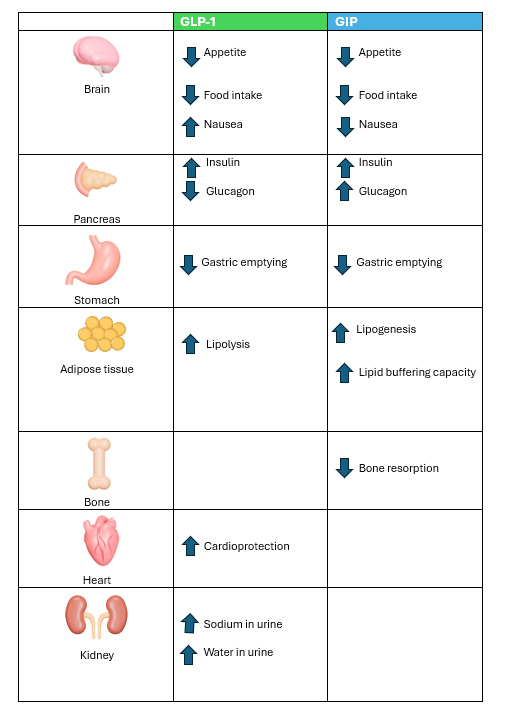Mounjaro (tirzepatide) is a highly effective weight-loss medication that reduces appetite and slows stomach emptying, making it easier to stick to a lower-calorie diet. The SURMOUNT 1 trials showed that when used at the highest maintenance dose of Mounjaro 15mg, it caused the most weight loss after 72 weeks. It helped study participants lose up to 22.5% of their starting body weight. Sounds too good to be true, so what’s the catch? What are Mounjaro side effects? In this blog, we will go over all the Mounjaro side effects and along the way, we will also provide some background on this blockbuster weight loss injection.
Please use the navigational table below to skip to topics of interest.
Table of contents
- What is Mounjaro?
- How effective is Mounjaro?
- What are the ten most common side effects of Mounjaro?
- Side effects of Mounjaro
- Mounjaro related nausea and vomiting
- Mounjaro related diarrhoea
- Mounjaro related constipation
- Mounjaro and dehydration
- Mounjaro injection site reactions
- Dizziness caused by Mounjaro
- Low blood pressure caused by Mounjaro
- Stomach pains caused by Mounjaro
- Indigestion (or dyspepsia) caused by Mounjaro
- Stomach bloating caused by Mounjaro
- Burping or eructation caused by Mounjaro
- Gas (flatulence) caused by Mounjaro
- Reflux or heartburn caused by Mounjaro
- Can I drink alcohol while using Mounjaro?
- Can I take Mounjaro with levothyroxine?
- Does Mounjaro cause thyroid cancer?
- How much weight can I lose with Mounjaro?
- Does Mounjaro help with sleep apnoea?
- Does Mounjaro cause hair loss?
- How long do the side effects of Mounjaro last?
- Should I stop taking Mounjaro once I’ve reached my target weight?
- Can I start Mounjaro at 5 mg?
- Can I stay on 2.5 mg of Mounjaro?
- Can you lose weight on 2.5 mg of Mounjaro?
- When do you move from 2.5 mg to 5 mg of Mounjaro?
- Can you take Mounjaro every 10 days?
- Which maintenance dose produces the most weight loss?
- References:
-
 Mounjaro 12.5mg InjectionPrice range: £422.50 through £1,640.00
Mounjaro 12.5mg InjectionPrice range: £422.50 through £1,640.00 -
 Mounjaro 7.5mg InjectionPrice range: £323.75 through £1,265.00
Mounjaro 7.5mg InjectionPrice range: £323.75 through £1,265.00 -
 Mounjaro 5mg InjectionPrice range: £229.99 through £899.99
Mounjaro 5mg InjectionPrice range: £229.99 through £899.99
What is Mounjaro?
Mounjaro was developed by Eli Lilly and contains the active ingredient, tirzepatide. It combines two chemically modified gut hormones—glucagon-like peptide-1 (GLP-1) and glucose-dependent insulinotropic polypeptide (GIP).
These hormones, called incretins, stimulate insulin release in response to food intake. Because Mounjaro has GLP-1 and GIP properties, it is known as a “twincretin”.
Incretins like GLP-1 and GIP contribute to weight loss by:
Early research on diet-induced obese (DIO) mice showed that combining GLP-1 and GIP resulted in significantly greater weight loss. Recognising its potential, Eli Lilly patented tirzepatide in 2016 and later validated its effectiveness in humans through the SURMOUNT trials.
The table below highlights the effects of GLP-1 and GIP.

How effective is Mounjaro?
Before we start addressing the Mounjaro side effects, we thought it would be good to go over just how effective Mounjaro is in causing weight loss.
The SURMOUNT 1 trial was one of the first trials that got people’s attention with regard to Mounjaro’s ability to cause weight loss.
The trial was designed to study the weight-loss potential of tirzepatide or Mounjaro in non-diabetic individuals with obesity or who were overweight. Participants included those with:
- A body mass index (BMI) of 30 kg/m² or higher, or
- A BMI of 27 kg/m² or higher with at least one weight-related condition, such as high blood pressure.
Over 72 weeks, participants taking the highest dose of tirzepatide (15 mg) lost an average of 22.5% of their body weight, with nearly 90% achieving at least 5% weight loss. In comparison, the GLP-1-based medication semaglutide delivers an average weight loss of 12.4%. These findings highlight Mounjaro’s superior weight loss ability.
The table below gives an idea of the week-by-week weight loss you can expect when taking Mounjaro.
Mounjaro side effects
The SURMOUNT 1 trial assigned 2539 adults with a body-mass index (BMI) of 30 or more, or 27 or more and at least one weight-related complication, excluding diabetes, in a 1:1:1:1 ratio, to receive once weekly by subcutaneous injection:
- Tirzepatide 5mg (Mounjaro 5mg)
- Tirzepatide 10mg (Mounjaro 10mg)
- Tirzepatide 15mg (Mounjaro 15mg)
- Placebo
The trial lasted for 72 weeks and included a 20-week dose escalation period. The trial demonstrated that tirzepatide (Mounjaro) caused impressive weight loss but what about the side effects? Let’s explore what the trial turned up.
| Week | Tirzepatide (5mg) | Tirzepatide(10mg) | Tirzepatide (15mg) | Placebo |
| 0 | 105 kg | 105 kg | 105 kg | 105 kg |
| 4 | 101 kg | 100.5 kg | 100 kg | 104.5 kg |
| 8 | 96.5 kg | 95.5 kg | 95 kg | 104 kg |
| 12 | 93.5 kg | 91.5 kg | 90 kg | 103.5 kg |
| 16 | 91.5 kg | 89 kg | 87 kg | 103 kg |
| 24 | 90 kg | 86 kg | 84.5 kg | 102.5 kg |
| 36 | 89.3 kg | 84.5 kg | 83 kg | 102.4 kg |
| 48 | 89 kg | 83.5 kg | 82 kg | 102.4 kg |
| 72 | 88.6 kg | 82.6 kg | 81.2 kg | 102.4 kg |
What are the ten most common side effects of Mounjaro?
The 10 most common side effects of Mounjaro from the SURMOUNT 1 trial were
Mounjaro’s most common side effect was nausea
Mounjaro’s second most common side effect was diarrhoea
Mounjaro’s third most common side effect was constipation
Mounjaro’s fourth most common side effect was dyspepsia or indigestion
Mounjaro’s fifth most common side effect was vomiting
Mounjaro’s sixth most common side effect was headache
Mounjaro’s seventh most common side effect was abdominal pain
Mounjaro’s eighth most common side effect was alopecia or hair loss
Mounjaro’s ninth most common side effect was dizziness
Mounjaro’s tenth most common side effect was eructation…the posh word for burping.
The following table is taken from the results of the SURMOUNT 1 trial, the figures indicate the percentage of participants who experienced the side effects.
| Side effect | Tirzepatide 5mg | Tirzepatide 10mg | Tirzepatide 15mg | Placebo |
| Nausea | 24.6 | 33.3 | 31 | 9.5 |
| Diarrhoea | 18.7 | 21.2 | 23 | 7.3 |
| Constipation | 16.8 | 17.1 | 11.7 | 5.8 |
| Dyspepsia or indigestion | 8.9 | 9.7 | 11.3 | 4.2 |
| Vomiting | 8.3 | 10.7 | 12.2 | 1.7 |
| Headache | 6.5 | 6.8 | 6.5 | 6.5 |
| Abdominal pain | 4.9 | 5.3 | 4.9 | 3.3 |
| Alopecia or hair loss | 5.1 | 4.9 | 5.7 | 0.9 |
| Dizziness | 4.1 | 5.5 | 4 | 2.3 |
| Eructation or burping | 3.8 | 5.2 | 5.6 | 0.6 |
Have questions about Mounjaro?
Get a FREE telephone consultation with one of our pharmacists, who will call you and help you understand what the right options are for you.
Call me about Mounjaro
| Week | Tirzepatide (5mg) | Tirzepatide(10mg) | Tirzepatide (15mg) | Placebo |
| 0 | 231 lbs | 231 lbs | 231 lbs | 231 lbs |
| 4 | 222.2 lbs | 221.3 lbs | 220.5 lbs | 230 lbs |
| 8 | 212.7 lbs | 210.5 lbs | 209.4 lbs | 229 lbs |
| 12 | 206 lbs | 201.6 lbs | 198.4 lbs | 228 lbs |
| 16 | 201.6 lbs | 196.2 lbs | 191.8 lbs | 227 lbs |
| 24 | 198.4 lbs | 189.6 lbs | 186.2 lbs | 226 lbs |
| 36 | 196.8 lbs | 186.3 lbs | 183 lbs | 225.8 lbs |
| 48 | 196.2 lbs | 184 lbs | 180.7 lbs | 225.8 lbs |
| 72 | 195.3 lbs | 182.1 lbs | 179 lbs | 225.8 lbs |
Side effects of Mounjaro
The patient information leaflet that accompanies your medication lists the following common side effects when using Mounjaro (tirzepatide) for weight loss:
Low blood sugar (hypoglycaemia) and Mounjaro
Although Mounjaro (tirzepatide) is designed to help regulate blood sugar levels, it can sometimes lead to low blood sugar, especially when used alongside other diabetes medications like sulphonylureas or insulin.
When Mounjaro is combined with insulin or sulphonylureas, it can cause blood sugar to drop too low.
If you’re taking insulin or a sulphonylurea along with Mounjaro, your doctor may need to adjust the doses of these medications to avoid hypoglycaemia (low blood sugar).
This side effect is listed as very common and common in the Mounjaro patient information leaflet.
Symptoms of low blood sugar
Signs of low blood sugar can include:
- Headaches
- Feeling drowsy or weak
- Dizziness
- Increased hunger
- Confusion or irritability
- Fast heartbeat and sweating
If you experience any of these symptoms, it’s important to treat them quickly. Your doctor will guide you on how to raise your blood sugar safely, typically by consuming something sugary.
Be sure to monitor your blood sugar levels regularly and consult your healthcare provider if you have concerns about managing them while using Mounjaro.
Mounjaro very common side effects:
When referring to the very common side effects we mean that may affect more than 1 in 10 people.
- Nausea
- Vomiting
- Diarrhoea
- Constipation
These effects are typically mild and are usual when starting the dose escalation period of Mounjaro when your body is becoming accustomed to it. Usually, these side effects decrease over time, however, if they are severe you should speak to your doctor straight away.
Managing very common side effects of Mounjaro
Mounjaro related nausea and vomiting
Mounjaro sickness refers to the nausea and vomiting that can occur while using the medication. These symptoms are generally managed in similar ways.
- Drink small amounts of fluid frequently (mainly water or electrolyte drinks)
- Eat small, plain meals, if possible, so no spicy curries!
- Avoid rich, fatty, or greasy foods, so no fry-ups in the morning!
- Avoid caffeine, sugary drinks, or alcohol
- If you smoke, try to avoid smoking, especially on an empty stomach
- Get fresh air
- Rest when needed
- When feeling nauseous try distraction techniques, anything that helps you get your mind off how your stomach is feeling. This could be watching TV, reading, or going for a walk, anything that works for you.
- Try over-the-counter or prescription anti-sickness medications, after consulting with a pharmacist or doctor
- Take your Mounjaro dose with food, as this may help reduce some of the symptoms
Take your time when getting back to normal eating, try to re-introduce foods slowly, giving your stomach time to adjust. Frequent vomiting can lead to dehydration and if you find that you just can’t keep anything down, speak to your doctor. For signs of dehydration see below.
Mounjaro related diarrhoea
If you experience diarrhoea while taking Mounjaro, here’s how you can manage it:
- Drink plenty of fluids, mainly water or drinks like Diarolyte that help replace lost electrolytes
- Avoid spicy, fatty, rich, or greasy foods-again so no morning fry-ups!
- Avoid caffeine, as this has a diuretic effect and can make the dehydration worse.
- Stay away from fruit juices, or alcohol.
- You can use over-the-counter medicines like loperamide, but only for 1 or 2 days. Don’t take it longer than 48 hours without checking with your doctor
- Try to rest and avoid stress.
Once you start feeling better, try eating small amounts of plain food and gradually add other foods back into your diet. Introducing food too quickly can upset your stomach, so take it slow. Remember to stay hydrated, as diarrhoea can lead to dehydration. Read the section below to recognise signs of dehydration and what to do about it. If the diarrhoea is severe or continuous with no signs of improvement contact your doctor.
Mounjaro related constipation
If you experience constipation while taking Mounjaro, here are some tips to help manage it:
Here are some helpful tips to manage constipation:
- Eat more fibre: Include high-fibre foods in your diet, such as fruits, vegetables, whole grains, and legumes (like beans and lentils), to help move things along.
- Stay hydrated: Drink plenty of water throughout the day to keep stools soft and prevent dehydration, which can worsen constipation.
- Exercise regularly: Physical activity can stimulate bowel movement. Try walking, stretching, or other gentle exercises to get your digestive system moving.
- Establish a routine: Try to go to the bathroom at the same time every day, especially after meals, to help train your body to have regular bowel movements.
- Avoid holding it in: When you feel the urge to go, don’t wait. Delaying can make constipation worse.
- Try stool softeners or laxatives: Over-the-counter stool softeners or mild laxatives can help relieve constipation. However, use them sparingly and consult with a healthcare provider if needed.
- Eat smaller, more frequent meals: Eating smaller meals throughout the day can help if you feel full or bloated. Avoid large meals that can cause discomfort.
- Reduce stress: Stress can affect digestion. Practising relaxation techniques like deep breathing or meditation can help manage stress and improve bowel function.
If your constipation doesn’t improve with lifestyle changes and treatment, it’s important to consult your doctor. Severe constipation (when you can’t pass stool for more than 3 days) can be very painful and may require prescription laxatives or other treatments.
In rare cases, a bowel obstruction can occur, which is a medical emergency. If this happens, call 999 immediately. Symptoms of a bowel obstruction include bloating, stomach pain, cramping, swelling, vomiting, difficulty passing gas, fever, and loss of appetite.
Mounjaro and dehydration
Dehydration occurs when your body loses more fluids than it takes in, which can lead to serious health issues. Recognising the signs early can help prevent complications.
Signs of dehydration include:
- Thirst
- Dark yellow urine or reduced urine output
- Dry mouth or throat
- Fatigue or dizziness
- Headache
- Confusion or irritability
What to do about dehydration:
- Drink water regularly, even if you’re not thirsty
- Consume electrolyte drinks to replenish lost minerals
- Eat hydrating foods like fruits and vegetables
- Avoid drinks that can dehydrate you, such as alcohol or caffeine
- Rest and avoid strenuous activities until you feel better
Mounjaro’s common side effects
Mounjaro’s common side effects may affect up to 1 in 10 people and include the following.
- Allergic reactions (hypersensitivity), such as rash, itching, and eczema
- Dizziness reported in patients undergoing weight management treatment
- Low blood pressure observed in patients receiving treatment for weight management
- Abdominal pain
- Indigestion (dyspepsia)
- Stomach bloating
- Burping (eructation)
- Gas (flatulence)
- Reflux or heartburn (gastroesophageal reflux disease – GERD), a condition where stomach acid moves up the oesophagus
- Hair loss is seen in patients undergoing weight management treatment
- Fatigue (tiredness)
- Injection site reactions, such as redness or itching
These common Mounjaro side effects are typically mild and generally resolve, however, if they persist or get worse contact your doctor.
-
 Mounjaro 10mg InjectionPrice range: £323.75 through £1,265.00
Mounjaro 10mg InjectionPrice range: £323.75 through £1,265.00 -
 Mounjaro 5mg InjectionPrice range: £229.99 through £899.99
Mounjaro 5mg InjectionPrice range: £229.99 through £899.99 -
 Mounjaro 2.5mg InjectionPrice range: £174.99 through £649.99
Mounjaro 2.5mg InjectionPrice range: £174.99 through £649.99
Managing common side effects of Mounjaro
Mounjaro injection site reactions
If you experience injection site reactions with Mounjaro, here’s how to manage them:
- Use an antihistamine (either a tablet or cream) if the site feels itchy
- Rotate your injection site each week by using a different area of your body or a different spot on the same side
- Ensure the injection area is thoroughly cleaned before injecting
- Always use a new, straight needle for each injection
- Consider using an ice pack before injecting to numb the area or after injecting to reduce pain and inflammation
If these steps don’t help or if the reaction becomes severe, consult your doctor for further advice.
Dizziness caused by Mounjaro
If you experience dizziness while taking Mounjaro, here are some steps you can take to manage it:
- Drink plenty of fluids to stay hydrated
- Lie down until the dizziness passes, then get up slowly and carefully
- It goes without saying, do not drive or operate heavy machinery if dizzy
- Ensure you’re getting enough rest
- Reduce stress by finding ways to manage and relax, as stress can contribute to dizziness
- Try taking your dose of Mounjaro after eating or drinking, especially if you experience dizziness right after your injection
Dizziness is more likely if your blood sugar levels are low (hypoglycaemia), though it can occur even with normal blood sugar levels. If dizziness is accompanied by symptoms like headache, weakness, or irritability, it’s important to speak with your doctor so they can check your blood sugar levels. People with type 2 diabetes should be especially cautious, as Mounjaro can increase the risk of hypoglycaemia if used with insulin.
Low blood pressure caused by Mounjaro
If you experience low blood pressure (hypotension) while using Mounjaro, here are some steps you can take to manage it:
- Increase Fluid Intake: Drink plenty of water throughout the day to help raise your blood pressure and prevent dehydration.
- Eat Small, Frequent Meals: Large meals can cause a drop in blood pressure. Eating smaller meals throughout the day can help manage symptoms.
- Avoid Sudden Position Changes: Get up slowly from sitting or lying down to prevent dizziness and light-headedness, which are common with low blood pressure.
- Monitor Your Blood Pressure: Regularly check your blood pressure to keep track of changes and discuss any significant drops with your healthcare provider.
If you continue to experience symptoms of low blood pressure, such as dizziness, fainting, or confusion, contact your doctor. They may adjust your dose of Mounjaro or suggest other treatments to help manage your blood pressure.
Stomach pains caused by Mounjaro
If you experience stomach pain while using Mounjaro, here are some ways to manage it:
- Eat a balanced, healthy diet: Focus on a variety of fruits, vegetables, whole grains, and lean proteins to support your digestive health.
- Avoid trigger foods: Steer clear of greasy, oily, spicy, acidic, or rich foods, as they can worsen stomach discomfort.
- Eat small meals frequently: Instead of large meals, try eating smaller portions throughout the day to avoid overwhelming your stomach.
- Use a hot water bottle: Applying heat to the stomach can help soothe pain. Over-the-counter painkillers, such as paracetamol, can also provide relief (but check with your pharmacist or doctor before using them).
- Consult a pharmacist: If the pain persists, contact us or talk to your pharmacist about over-the-counter treatments that can help, help, such as antacids for acid reflux or medications for nausea.
Stomach pain with Mounjaro is often temporary and could be related to other common side effects like nausea or indigestion.
However, if the pain is severe, persistent, or doesn’t improve, it could indicate a more serious issue, like pancreatitis. In such cases, it’s essential to speak with your doctor immediately. If you experience severe, ongoing stomach pain, call your GP, contact 111, or go to A&E for further evaluation.
Indigestion (or dyspepsia) caused by Mounjaro
- Eat smaller, more frequent meals to avoid overwhelming your digestive system.
- Avoid spicy, greasy, and fatty foods that can irritate your stomach lining.
- Limit alcohol and caffeine consumption as they can worsen indigestion.
- Try to eat more plain, non-acidic foods like bananas, rice, and oatmeal.
- Drink plenty of water throughout the day to help digestion.
- Avoid lying down immediately after eating; try to stay upright for at least an hour.
- Consider using over-the-counter antacids or proton pump inhibitors, if you are not sure which one to try contact us for a FREE consultation.
- Try herbal teas like ginger or peppermint, which may help soothe the stomach.
Stomach bloating caused by Mounjaro
- Stay hydrated by drinking plenty of water throughout the day.
- Avoid gas-producing foods like beans, carbonated drinks, and cruciferous vegetables.
- Eat smaller meals throughout the day instead of large, heavy meals.
- Try walking or light exercise after meals to encourage digestion.
- Use an over-the-counter anti-bloating product, such as Wind-Eze, or if you are not sure, contact us for a FREE consultation.
- Avoid swallowing air by eating slowly and not talking while chewing.
- Keep track of foods that trigger bloating by maintaining a food diary.
- Consider taking a probiotic to support digestion and gut health, if you are not sure which one to take, contact us for a FREE Mounjaro weight-loss consultation.
Burping or eructation caused by Mounjaro
- Eat slowly to prevent swallowing air that contributes to burping.
- Avoid carbonated drinks, which release gas into the stomach.
- Chew food thoroughly and avoid overeating to aid digestion.
- Avoid chewing gum or smoking, as it can lead to swallowing air.
- Drink water between meals rather than with meals to prevent bloating and burping.
- If burping persists, consider using an antacid or anti-gas medication, such as Wind-Eze. Or contact us for further advice and a FREE Mounjaro weight-loss consultation.
- Limit the intake of high-fat or fried foods, which can cause discomfort.
- Try to reduce stress, as anxiety can sometimes cause excessive burping.
Gas (flatulence) caused by Mounjaro
- Reduce or avoid foods known to cause gas, such as beans, onions, and broccoli.
- Drink plenty of fluids, especially water, to aid digestion.
- Eat smaller, more frequent meals rather than large meals to reduce bloating and gas.
- Incorporate light physical activity, like walking, to help reduce gas buildup.
- Try over-the-counter products like simethicone to relieve gas.
- Avoid high-sugar or sugary foods that can ferment in your digestive tract.
- Keep a food diary to identify and avoid triggers that worsen gas.
- Avoid swallowing air by eating slowly, not talking while eating, and avoiding drinking through straws.
Reflux or heartburn caused by Mounjaro
- Avoid foods and drinks that trigger acid reflux, such as spicy foods, citrus, and chocolate.
- Eat smaller meals throughout the day to prevent overloading the stomach.
- Stay upright for at least 30 minutes after eating to help keep stomach acid down.
- Sleep with your head raised to prevent acid from moving up into the oesophagus.
- Avoid lying down immediately after meals to reduce the risk of acid reflux.
- Consider using over-the-counter antacids or medications prescribed by your doctor.
- Reduce stress with relaxation techniques like deep breathing or yoga.
- Avoid smoking, as it can weaken the oesophageal sphincter and worsen heartburn.
Managing hair loss caused by Mounjaro
- Use compounded treatments like finasteride/dutasteride and minoxidil hair loss liquids from Medical Mojo to help stimulate hair growth.
- Maintain a nutrient-rich diet with vitamins and minerals important for hair health, such as biotin, iron, and zinc.
- Avoid high levels of stress, as it can contribute to hair loss.
- Consider using gentle hair care products that are free of harsh chemicals.
- Stay hydrated, as dehydration can impact hair growth and overall health.
- Regularly massage your scalp to improve blood circulation and promote healthy hair follicles.
- Avoid tight hairstyles or excessive heat styling, which can damage hair.
- Contact Medical Mojo for your FREE hair loss consultation or speak to your doctor if hair loss becomes severe, as they may recommend additional treatments or adjustments to your medication.
-
 Dutasteride 0.1% Minoxidil 10% Topical Hair Loss LiquidPrice range: £34.99 through £199.99
Dutasteride 0.1% Minoxidil 10% Topical Hair Loss LiquidPrice range: £34.99 through £199.99 -
 Finasteride 0.1% Caffeine 0.2% Topical Hair Loss LiquidPrice range: £20.99 through £125.94
Finasteride 0.1% Caffeine 0.2% Topical Hair Loss LiquidPrice range: £20.99 through £125.94 -
 Finasteride 0.1% Minoxidil 10% Topical Hair Loss SolutionPrice range: £29.99 through £170.99
Finasteride 0.1% Minoxidil 10% Topical Hair Loss SolutionPrice range: £29.99 through £170.99
Managing fatigue caused by Mounjaro
- Supplement with Coenzyme Q10 (CoQ10) to support energy production in your cells and combat fatigue.
- For more information about Medical Mojo’s compounded buccal Coenzyme Q10, please contact us and learn how to get one month free with your first purchase of Mounjaro.
- Stay hydrated by drinking plenty of water throughout the day.
- Maintain a balanced diet rich in whole foods, including vegetables, lean proteins, and healthy fats.
- Engage in regular physical activity, such as walking or yoga, to improve overall energy levels.
- Aim for a consistent sleep schedule, ensuring you get at least 7-8 hours of quality sleep each night.
- Avoid excessive caffeine or alcohol, which can disrupt sleep patterns and energy levels.
- Break up your day with short, regular breaks to avoid burnout and maintain focus.
- If fatigue persists, consult your doctor to ensure no underlying health issues are contributing to your tiredness.
Are weight loss treatments making you tired, or have they led to a sudden increase in hair loss? Do you struggle with sleep?
Get a free month’s supply of one of our compounded treatments for energy, hair loss or sleep, with your first purchase of Mounjaro or Wegovy from Medical Mojo.
Claim your FREE offer
Mounjaro -uncommon side effects
Uncommon side effects affect up to 1 in 100 people.
Changed Sense of Taste: Some people may notice that food tastes different while using Mounjaro. This can lead to a reduced appetite or make food less enjoyable. If you experience this, it may pass over time as your body adjusts to the medication.
Increased Heart Rate: Some people may experience a faster pulse or heart rate, but this is more commonly seen in doses for diabetes rather than for weight management.
Elevated Pancreatic Enzymes: An increase in certain pancreatic enzymes, such as amylase, can be detected in the blood. This could indicate a problem with the pancreas.
Gallstones: Gallstones are hardened deposits of bile (a digestive fluid) that can form in the gallbladder, a small organ under your liver.
Gallstones are usually silent until they block the bile ducts, causing intense pain in the stomach. This pain can last from a few minutes to hours, and it may be accompanied by confusion, fever, and chills.
Gallstones can cause sharp stomach pain, especially after eating fatty foods. If you experience sudden, severe stomach pain, it’s important to contact your doctor.
Injection Site Pain: This refers to any discomfort or pain you may feel where the Mounjaro injection is given, typically on your skin.
This can include soreness, redness, or swelling at the site. To help reduce pain, try switching the spot where you inject, or apply ice to numb the area before injecting.
Increased Calcitonin Levels: Some people may have higher levels of calcitonin, a hormone that regulates calcium levels in the blood.
Cholecystitis (Gallbladder Infection): Cholecystitis is an infection or inflammation of the gallbladder, an organ located near your liver that stores bile. Symptoms of this infection include sudden, severe pain in the upper right part of your stomach, fever, and yellowing of the skin or eyes (called jaundice). If you experience these symptoms, it’s important to see a doctor immediately, as it may require treatment.
These side effects are uncommon but can be more serious. If you experience any of these symptoms, contact your doctor immediately. If you suspect you have gallstones or cholecystitis and can’t reach your doctor, call 111 or go to the nearest A&E, as these conditions typically require hospital treatment.
Mounjaro-Serious side effects
Thankfully Mounjaro’s serious side effects are uncommon and rare.
Mounjaro-Uncommon serious side effects
Thankfully Mounjaro’s uncommon serious side effects may affect 1 in 100 people and include:
- Acute Pancreatitis: This is an inflammation of the pancreas, which can cause severe and lasting pain in the stomach and back. If you experience intense stomach or back pain, it is important to see a doctor immediately.
Mounjaro -Rare serious side effects
Mounjaro’s rare serious side effects may affect up to 1 in 1000 people and include:
- Severe Allergic Reaction (Anaphylaxis or Angioedema): This can cause difficulty breathing, swelling of the face or lips, and trouble swallowing. This is a medical emergency.
If you think you have an inflamed pancreas, contact your doctor immediately or go to A&E for treatment.
A severe allergic reaction requires immediate medical attention. Call 999 or go to A&E right away. Be sure to bring your medication packet with you and inform healthcare professionals that you are taking Mounjaro.
Reporting new Mounjaro side effects
If you experience any side effects, including those not mentioned in the Mounjaro patient information leaflet, you should speak to your doctor, pharmacist, or nurse. You can also report side effects directly through the Yellow Card Scheme. Visit the website at www.mhra.gov.uk/yellowcard or search for “MHRA Yellow Card” in the Google Play or Apple App Store. Reporting side effects helps provide valuable information about the safety of this medication.
When do Mounjaro side effects start?
Most side effects begin when you first start using Mounjaro or after your dose is increased. The adjustment period can cause nausea, vomiting, or diarrhoea. These side effects usually subside after a few days to a few weeks as your body gets used to the medication. If they persist or worsen, consult your doctor.
Mounjaro and cancer.
Before we conclude with Mounjaro’s side effects, we will just say a quick word about Mounjaro and cancer. For a more in-depth analysis, have a read of our blog, “Does Mounjaro cause thyroid cancer?”
Mounjaro and thyroid cancer
Concerns about the potential link between GLP-1 medications, like Mounjaro, and thyroid cancer stem from pre-clinical studies in rodents, where high doses of GLP-1 drugs caused thyroid tumours. However, Unlike rodents, humans and primates have very few or no GLP-1 receptors on their thyroid C cells, suggesting that the risks observed in rodents may not be relevant to people.
A recent large study published in BMJ on April 10, 2024, found no significant increase in thyroid cancer risk for users of GLP-1 receptor agonists, including Mounjaro. The study, which followed over 145,000 GLP-1 users for an average of 3.9 years, showed thyroid cancer rates similar to those on other diabetes medications.
Researchers concluded that GLP-1 drugs do not significantly increase the risk of thyroid cancer, with any potential risk being minimal. The findings reassure that GLP-1 drugs, including Mounjaro, are unlikely to pose a substantial risk for thyroid cancer in humans.
What should you do if you are worried about Mounjaro and cancer?
If you’re using Mounjaro or similar medications, here are some important steps to follow:
- Follow your prescribed treatment: The benefits of GLP-1 medications in managing diabetes and aiding weight loss generally outweigh any potential risks for most patients.
- Talk to your doctor: If you have a personal or family history of medullary thyroid cancer (MTC) or multiple endocrine neoplasia type 2 (MEN-2), make sure to inform your healthcare provider before starting or continuing treatment.
- Watch for symptoms: Be alert for signs such as lumps in the neck or difficulty swallowing, and notify your doctor if you experience any of these symptoms.
Mounjaro side effects conclusion
Mounjaro is an effective weight loss medication that can help many individuals achieve and maintain a healthy weight.
While most side effects are mild and temporary, it is essential to monitor your body’s response and work closely with your doctor or contact the prescribers at Medical Mojo to manage any issues.
If you experience severe side effects such as pancreatitis or an allergic reaction, seek immediate medical attention.
If you have any concerns about any side effects you may be experiencing, contact Medical Mojo for your FREE Mounjaro weight-loss consultation.
Frequently asked questions about Mounjaro
Can I drink alcohol while using Mounjaro?
It’s best to limit alcohol consumption while taking Mounjaro, as it may increase the risk of side effects like nausea and dizziness. For more information, check out our blog, “Can you drink alcohol while taking Mounjaro?”
Can I take Mounjaro with levothyroxine?
There are no confirmed interactions between Mounjaro and levothyroxine, but it’s important to monitor your thyroid levels closely. For more details, read our blog, “Can I take Mounjaro with levothyroxine?”#
Does Mounjaro cause thyroid cancer?
While concerns arose from pre-clinical studies in rodents, there’s little evidence suggesting Mounjaro causes thyroid cancer in humans. For further details, see our blog, “Does Mounjaro cause thyroid cancer?”
How much weight can I lose with Mounjaro?
In the SURMOUNT 1 trial, results showed the following weight loss with Mounjaro:
- 5mg: 16.4 kg (36.1 lbs)
- 10mg: 22.4 kg (49.4 lbs)
- 15mg: 23.8 kg (52.5 lbs)
Does Mounjaro help with sleep apnoea?
Studies suggest that Mounjaro may help improve symptoms of sleep apnoea. For more information, visit our blog, “Mounjaro and sleep apnoea.”
Does Mounjaro cause hair loss?
Mounjaro has been linked to hair loss in about 5% of users, though it’s unclear if this is due to the medication or rapid weight loss. For more information, read our blog, “Does Mounjaro cause hair loss?”
How long do the side effects of Mounjaro last?
Side effects like nausea, bloating, and constipation are typically temporary and will improve after a few days or weeks as your body adjusts. For more details, check out our blog, “How long do the side effects of Mounjaro last?”
Should I stop taking Mounjaro once I’ve reached my target weight?
Stopping Mounjaro after reaching your target weight may make it harder to maintain weight loss and could lead to regaining weight due to increased appetite and unhealthy eating habits.
Can I start Mounjaro at 5 mg?
No, the starting dose of Mounjaro is 2.5 mg. Following the prescribed dosing schedule is important for minimizing side effects and allowing your body to adjust.
Can I stay on 2.5 mg of Mounjaro?
Staying on 2.5 mg long-term is generally not recommended. After about 4 weeks, the dose should be increased to 5 mg. If you experience severe side effects, contact us to discuss alternatives or adjustments.
Can you lose weight on 2.5 mg of Mounjaro?
Some weight loss may occur at 2.5 mg, but more significant results are typically seen with higher doses.
When do you move from 2.5 mg to 5 mg of Mounjaro?
After 4 weeks on 2.5 mg, you will typically increase to 5 mg. If you experience any side effects, consult us to discuss how to proceed with your dosage.
Can you take Mounjaro every 10 days?
No, Mounjaro should be taken weekly, at the same time and on the same day. Taking it every 10 days could result in hunger between doses. You can stay on a lower maintenance dose while keeping the weekly schedule.
Which maintenance dose produces the most weight loss?
The SURMOUNT 1 trial showed that the most weight loss occurred with the 15mg dose (23.8 kg over 72 weeks), followed by 10mg (22.4 kg) and 5mg (16.4 kg).
Medical Mojo’s customised weight loss program
At Medical Mojo, we offer personalized weight loss coaching to help you achieve your goals. Our program includes:
- Weekly check-ins to monitor progress and keep you motivated
- Personalised coaching for continuous support designed to empower and motivate you for long-term weight loss success.
- FREE needles and sharps bins to get you started
Let Medical Mojo help you achieve your weight loss goals. With expert guidance, individualized plans, and the right resources, successful weight loss has never been more achievable. Take the first step today and see how we can support your path to a healthier, happier you.
Disclaimer: This article is for informational purposes only and is not a substitute for professional medical advice.
for informational purposes only and is not a substitute for professional medical advice.
References:
- BMJ. (2024). Glucagon-like peptide 1 receptor agonist use and risk of thyroid cancer: Scandinavian cohort study. BMJ, 385, e078225. https://doi.org/10.1136/bmj-2023-078225 (Published 10 April 2024).
- Bokvist, K.B., Finan, B., Friedrichsen, S., & Heise, T. (2016). Glucagon-like peptide-1 receptor (GLP-1R) agonists combined with glucose-dependent insulinotropic peptide (GIP) receptor agonists for the treatment of metabolic disorders. United States Patent US9474780B2. Retrieved from https://patents.google.com/patent/US9474780/en.
- Coskun, T., et al. (2018). Tirzepatide, a dual GLP-1 and GIP receptor agonist, induces significant weight loss in patients with obesity. Diabetes Care, 41(10), 2100–2108.
- Eli Lilly and Company. (2021). Mounjaro (tirzepatide) 2.5 mg, 5 mg, 10 mg, and 15 mg solution for injection in pre-filled pen: Patient information leaflet. Retrieved from https://www.medicines.org.uk/emc/files/pil.15481.pdf
- Jastreboff, A.M., Aronne, L.J., Ahmad, N.N., Wharton, S., Connery, L., Alves, B., Kiyosue, A., Zhang, S., Liu, B., Bunck, M.C. and Stefanski, A., 2022. Tirzepatide once weekly for the treatment of obesity. New England Journal of Medicine, 387(3), pp.205-216.
- Lars Wichmann Madsen, Jeffrey A. Knauf, Carsten Gotfredsen, Andrew Pilling, Ingrid Sjögren, Søren Andersen, Lene Andersen, Anne Sietske de Boer, Katia Manova, Afsar Barlas, Sushil Vundavalli, Niels C. Berg Nyborg, Lotte Bjerre Knudsen, Anne Marie Moelck, James A. Fagin, GLP-1 Receptor Agonists and the Thyroid: C-Cell Effects in Mice Are Mediated via the GLP-1 Receptor and not Associated with RET Activation, Endocrinology, Volume 153, Issue 3, 1 March 2012, Pages 1538–1547,
- Mounjaro Prescribing Information. (2021). Mounjaro (tirzepatide) injection. Eli Lilly and Company.
- Rosol TJ. On-target Effects of GLP-1 Receptor Agonists on Thyroid C-cells in Rats and Mice. Toxicologic Pathology. 2013;41(2):303-309.
- Rubino, D. M., et al. (2023). SURMOUNT-1: A phase 3 trial of tirzepatide for weight loss in people with obesity or overweight. The New England Journal of Medicine, 389(6), 478-488.
- Sinha R, Papamargaritis D, Sargeant JA, Davies MJ. Efficacy and Safety of Tirzepatide in Type 2 Diabetes and Obesity Management. J Obes Metab Syndr. 2023 Mar 30;32(1):25-45.
- Unick, J.L., Pellegrini, C.A., Dunsiger, S.I., Demos, K.E., Thomas, J.G., Bond, D.S., Lee, R.H., Webster, J. and Wing, R.R., 2024. An Adaptive Telephone Coaching Intervention for Patients in an Online Weight Loss Program: A Randomized Clinical Trial. JAMA Network Open, 7(6), pp.e2414587-e2414587.
- Wilding, J.P., Batterham, R.L., Calanna, S., Davies, M., Van Gaal, L.F., Lingvay, I., McGowan, B.M., Rosenstock, J., Tran, M.T., Wadden, T.A. and Wharton, S., 2021. Once-weekly semaglutide in adults with overweight or obesity. New England Journal of Medicine, 384(11), pp.989-1002.


